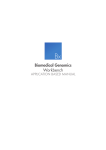Download User`s Manual
Transcript
Below is an example of how one might use SiVA to interrogate exome or targeted gene panels. This is meant as an illustrated guide not a detailed manual on exome analysis, approaches or strategies. This guide assumes a basic level of genetic and genomic knowledge. Log on to SiVA with a popular web browser (e.g.firefox) at genomics.csmc.edu/siva/ After successful login you should find something like the following screenshot: Upload and edit sample details: To upload a sample, click the green “Upload” button to upload a FASTA file or .vcf file (make sure to look at the Sample VCF for an acceptable .vcf file format). After you have uploaded your file. You will see (from left to right) 1) “My projects” directory (all projects registered to the user name), 2) “File names” (Files in the selected project directory), 3)”Created date” (Date file was uploaded 4), “Status” (if file upload has completed will read “Analyzed”); 5) “Size” (sizes of files uploaded), 6) “Study Type” (user determined at upload either Cancer or Genetic analysis”) 7) “Sources” (user determined at upload either Tissue or Blood) (8)“Race” (user determined at upload) 9) “Action” (user selectable options: “Edit”, “Make public”, “Delete”, “Share” (with another user)) Select “Edit” to edit file name details. Select “Make public” to make file publically viewable Select “Delete” to delete file Select “Share” to share with a colleague or Principle investigator who is already registered. When you share a variant results sample, please enter in the email or registered user, if the user is registered the user name will autopopulate. Search Variants_______________________________________________________________________ Click on one sample name to view results and to search variants. After clicking on one sample you can view in graphical detail a summary of variants You can mouse over each section to get more information of the variants. You can search for a Comment in the Search window above the Distribution of variants pie graph this is helpful if you are a principle investigator reviewing comments from a group member maybe who reviewed the variants previously. Once you upload the .VCF file and its annotated you can click “Export” on the far left (next to the Search key). Or you can search it and export only the searched values. You can then search or filter all the variants in the sample (e.g. 50K) to something that is more representative of the candidate mutation list (e.g. 1-‐50 SNPs). After you click search, a Search tab opens (see below) that includes many fields that will help you narrow down your variants to true positives or candidate mutations. Basic Search In the search Table, select or enter reasonable filters that will result in a query that selects for only candidate mutations. For Example, in the case below we are searching a sample for a mutation that is inherited and not found in a sibling. Specifically, in the search tab we have selected to narrow our search to Exons (by checking “Exons” in “Regions” box), only Non-‐Synonmous variants (by checking “non-‐synomous” in “Mutation type” box). Then narrowed the candidates by only looking at rare SNPs, by pulling down the “variants type” and “variant db” so that we selected “SNPs” (not indels) and “none” (for not in dbSNP). Then we enriched or selected for the heterozygous variants that represented at least 35 percent of the reads with at least a total coverage of 20. Advanced SNP filtering/Analysis Under the “Basic” SNP Filtering section is the “Advanced” SNP Search Window. In this window you can construct a list of genes that are routinely searched and upload the list to your account for future searches. This is helpful for routine searches. If you have 1 or 2 genes you just want to check then you can type the names of the genes in the window (As seen below in the screenshot where “Col2a1 was entered). Please use official human Gene Symbols only for this search. Variants “Specific” to one sample Under the Advanced SNP filtering there is a “Specific” filtering window to select for Variants that are uniquely found in one sample and/or not another sample. The Boolean query can be added sequentially with as many samples that are present in the users account. In this case, we selected not found in another sample to find a mutation that was unique and rare and not found in another sequencing sample. This can be very useful for separating out rare mutations from batch sequencing errors that may be in unrelated samples, as much as it is used to identify “denovo” mutations found in an unaffected parent for example. Dynamic Graphical user interfaces rapidly shows Summary of Filtering After filtering the graphical interface is updated with the information from the filtered variants as seen below. Variant Annotation Details to further identify true candidate mutations. After viewing the graphic summary, one can research the variant annotation in more detail by selecting the tab on the far right labeled “Overview”. When the tab is pulled down there reveals multiple annotation tabs. A. Variant Detail tab. If you select Variant Detail you will see the following information B. The second tab is “Annotation and Databases” and provides rich annotation of the variant frequency and AA changes. C. The Next tab Functional Prediction includes the results from several prediction algorithms on the effect of the variant on the mutation. Drilling down into Gene Biology and Gene annotation details.____________ After viewing the variants list, one can right click on the hypertext gene symbol to learn more information about the gene available in different databases like OMIM, ClinVar, etc. As seen below in the pop up menu in the screen shot. Finally, one can drill down into more variant detail by looking at the position of the variant in respect too other genomic data in UCSC genome browser. By left clicking on the hypertext position of the variant (as seen below in the screen shot) on can open a new window that opens at the variant position in the human genome in the USCS genome browser. This will open a new window allowing the user to overlay many other types of genomic information, including snp variants, expression, conservation, position in the gene etc. to help the user understand the true effect of the mutation/variant in context to the surrounding genome and other genomic information (See screen shot below).













![Lvn De Novo Board Game User Manual [VER 1.0]](http://vs1.manualzilla.com/store/data/005785305_1-ef88b505e9e90be8a5d323ed52b38254-150x150.png)